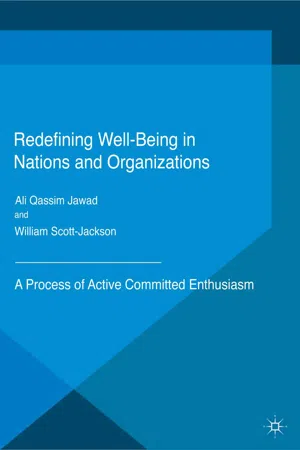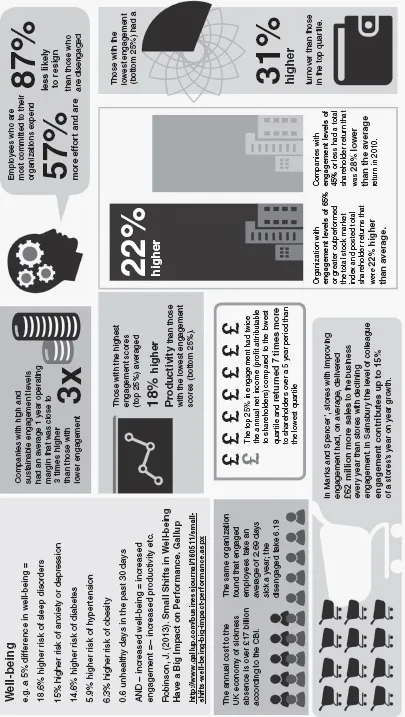![]()
1
Redefining Well-being and Engagement: Why Bother?
1.1 Introduction
National (government) and organizational (management) leaders have an obligation to maximize the well-being and engagement of their citizens and staff. This is not just a moral or socio-political responsibility. As we shall see, individuals and groups whose well-being and engagement are high tend to contribute more effectively than individuals whose well-being and engagement are low. So, for the country or organization, having fully engaged citizens/staff with high levels of well-being is a key factor in strategic national or organizational success, which may itself result in a greater sense of national or organizational well-being – a virtuous cycle.
This book adopts a multidisciplinary perspective in investigating how decision makers in both public and private sector institutions can intervene to help improve the well-being and engagement of their citizens/staff in order to achieve beneficial outcomes. The need for the book became clear to the authors (one with responsibility for government policy, the other with responsibility for developing organizational human capital), who recognized that research and practice was becomingly increasingly ‘siloed’. In order to bridge the gap between research and practice, it became evident to the authors that there was an opportunity to identify how policy, individual psychology and engagement together ultimately drive organizational and business outcomes.
In addition, as practitioners as well as researchers, the authors propose that the topic is best viewed as a complex process in order to model and assess the impact of potential interventions by policymakers and managers. In order to capture the various concepts within one framework, the book introduces, develops and demonstrates the application of a process for active committed enthusiasm (PACE), which (Figure 1.1) also clarifies the constructs (theoretical elements) themselves by clearly distinguishing between causes, constructs and outcomes.
As will be seen, the use of this process model has allowed some key ‘levers’ to be identified with which executives and decision makers in governments and organizations can intervene to maximize the well-being and engagement of their constituent stakeholders. The process model demonstrates, for example, that these key levers change significantly over time as individuals reach certain thresholds of material fulfilment (where their basic physical needs of housing or access to power are met) through economic development or organizational success.
The objective of this book, therefore, is to provide new ideas, models and clarity to help national leaders (government) and organizational leaders (management) to effectively assess and maximize individual well-being and engagement (and related constructs) in order to achieve beneficial outcomes. With perspectives from political, organizational and socio-psychological theory and practice, the book provides a comprehensive process framework for well-being and engagement interventions. Its scope moves beyond measurement to explore approaches to improvement, implementation and development.
The book has two specific perspectives, which distinguish it from many of the numerous papers and books in this general area:
1.It is written from the perspective of organized bodies (including private sector, public sector and charitable organizations and nations), rather than from the particular perspective of the individual. So the focus is not simply on how to improve individual well-being or engagement, which is clearly a worthwhile goal in its own right, but how organized bodies can maximize their citizens’/staff’s well-being and engagement in order to contribute to the goals of that body.
Figure 1.1 A process for active committed enthusiasm (PACE)
2.It is therefore written from the perspective that well-being and engagement serve an organizational purpose, as active rather than passive constructs and as components of a process which results in the achievement of those organizational goals. In nations, one could argue that the premise has a degree of circularity in that the organization; in this case, the nation exists to serve its citizens, so individual well-being is itself an outcome of the achievement of organizational goals as well as an input. In fact, this bidirectional causality is a common feature of the complex process we will be exploring and the same kind of argument could be put forward for any size or kind of organization, especially if we widen the population of interest to include other stakeholders. So, for example, donors to a charitable organization will be motivated, or not, by aspects of their own well-being and engagement with that body to help it achieve its goals. At the same time, their own well-being, through their sense of worth, self-esteem and meaningfulness, for example, will be enhanced by the charity’s achievement of its goals.
The book uses well-being and engagement as the most researched representatives of many related constructs, including ‘citizenship’ and ‘flourishing’ (Seligman 2012), for example, which are explored below. Well-being and engagement are widely and variously defined, with ‘well-being’ being seen as a component or outcome of health (Stein & Sadana 2015) or as a ‘wicked’ problem which is ill-defined and non-systemic (Bache et al. 2015), and the term ‘engagement’ is used at different times to refer to ‘psychological states, traits, and behaviours, as well as their antecedents and outcomes’ (Macey & Schneider 2008: 1).
Given the range of definitions, it is important therefore to clarify what we mean by well-being and engagement in the context of this work. This is discussed in detail below but, of the major ‘domains’ of well-being theory, this book focuses on well-being as a sustained, positive, perceived state of satisfaction with life (often described as subjective well-being), rather than just short-term happiness (or positive affect) or the absence of ‘ill-being’. Engagement is a more active state of committed enthusiasm toward an organization and its goals, where that organization could range from a social group through to a nation. As we shall see, research on engagement is located in the disciplines of management and organization while well-being is more closely associated with the disciplines of national policy and individual psychology, with very little cross-fertilization of ideas or evidence. However, seen as components of a process, well-being and engagement are highly related and, in fact, many recent studies of engagement identify well-being as a causal factor and many recent studies of well-being identify engagement as a causal factor.
The book therefore examines both constructs within the PACE process model and, in doing so, encompasses all types of organized bodies, from small groups through to nations. We illustrate some of the main points using a case study on the rapid development of the Sultanate of Oman, with its focus on well-being, from basic provision through to the current focus on intrinsically positive factors. This illustrates how leaders could utilize the process model to consider and compare the likely impacts of possible interventions, in a systematic and structured manner. The purpose of PACE is to assist the leaders of organized bodies to achieve national and organizational goals through maximizing the well-being and engagement of their citizens/staff and, as such, provides a useful framework for academic research and practical application.
We will argue that well-being and engagement are best seen as nodes within the PACE framework, whereas many current definitions conflate causes, antecedents and outcomes with the definitions of the constructs themselves. ‘Objective well-being’, for example, is a misnomer comprising a number of assumed causal factors, such as housing quality, which are in fact causal factors that, in turn, impact well-being itself.
1.2 Why is it important?
The authors will document the extensive research demonstrating associations and complex, often bidirectional, causal links between well-being and engagement and important outputs such as productivity, revenue, sick days, participation, Gross Domestic Product (GDP)/Shareholder value, emigration/retention and so on (Figure 1.2).
Although well-being and engagement have generally been treated as separate subjects in research and practice, they both have significant impact on the lives (personal, social and economic) of individuals, organizations and societies. Well-being is most often seen as a desirable outcome in its own right whereas engagement has generally been treated as a causal factor for increased productivity, success, effort, motivation and so on. However, these outcomes could also apply to well-being at a country level. Similarly, the causal factors of legitimized purpose and common vision, for example, would be claimed as key enablers of organizational engagement, yet these are equally valid for a country. One of the main differences is that well-being is seen as a fairly passive state of satisfaction with life, in the absence of stress, whereas engagement is seen as more active and closely aligned to enthusiasm and commitment. As the case study illustrates, as early as 1974, H.M. Sultan Qaboos Bin Said stressed that the national plan’s aim was not just the well-being but also the active participation of Omani nationals. Given their central importance, well-being and engagement have been the subject of extensive research, practice and theorizing for many years, with well-being, in particular, enjoying a current resurgence in interest. So why is this book needed?
Figure 1.2 Opportunities for improvement of well-being and engagement from a process perspective.
1.Higher levels of well-being and engagement have consistently been shown to significantly impact a wide range of highly desirable outcomes. For engagement, numerous studies have demonstrated significant positive impacts on operating income (52% difference: Towers Perrin-ISR 2006), sick days (around 4 days less pa: CBI-AXA 2003), customer focus (53% more: Right Management 2006), retention (87% less likely to leave: Corporate Leadership Council 2004) and many other key organizational outcomes. For well-being, in addition to being seen as a desirable outcome in itself, a negative difference of only 5% has been claimed (Robinson 2013) to result in:
•18.6% higher risk of sleep disorders
•15% higher risk of anxiety or depression
•14.6% higher risk of diabetes
•5.9% higher risk of hypertension
•6.3% higher risk of obesity
•0.6 less unhealthy days in the past 30 days
2.However, despite extensive research and investment, real-world engagement remains elusive with many surveys confirming a level of less than 25% of people in work being fully engaged (for example, Towers Watson 2014). Less than one-third (31.5%) of US workers were engaged in their jobs in 2014, while the majority of employees, 51%, were still ‘not engaged’ and 17.5% were ‘actively disengaged’ (Gallup 2015). The state of well-being globally is more difficult to assess given the wide variety of definitions, but the Gallup (2014) survey of over 130,000 respondents, using a composite index, suggests that ‘Globally, only 17% of the population are thriving in three or more elements [out of 5]’. So ‘best practice’ is either failing or is failing to be implemented. The book aims to merge useful findings from two very separate disciplines to produce insights and recommendations for researchers, policymakers and leaders of all types and sizes of organized bodies, including nations.
3.Despite extensive debate, the definitions of both constructs remain ambiguous. This book attempts to define both constructs in process terms, with inputs and outputs at various stages and levels of granularity. This process perspective is holistic and enables the weighting of causal factors to inform decisions on impactful interventions.
4.The focus of practice in both areas has tended toward measurement, whereas this book focuses on improvement, for which measurement is of course required. The focus on improvement enables a clear view of where and when to intervene in the PACE as well as which causal factors may have the most significant impact and which agencies, such as organizations (Quick et al. 2014) or government (Halpern 2008) could, or should, carry out relevant interventions.
5.Fifty-one of the wo...


